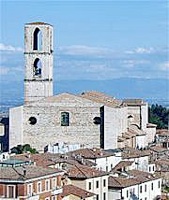The Dominicans were the first of the mendicant orders to settle in the Perugia. They are first documented here in 1234, when the podestà Ramberto de Gisleriis granted them two plots of land next to the parish church of Santo Stefano del Castellare. The secular clergy at this church were finding it difficult to cope with the demands of the rapidly growing parish, and the Dominicans effectively took over responsibility for the pastoral care of its inhabitants. Such was their success that they built a new church (later known as San Domenico Vecchio) as well as a convent on the site. The convent had a school of theology by 1260 and a fine library.
The Dominican Pope Benedict XI, who arrived in Perugia in 1304, formalised the friars’ ownership of Santo Stefano del Castellare. He also granted plenary indulgences to those celebrating Mass there on the feast of St Stephen (August 3rd). This attracted pilgrims, many of whom would have come from Assisi, where the Portiuncula Indulgence was available on August 1st and 2nd. This increased the friars' income, paving the way for the building of the present church. When he died in Perugia in July, 1304, he was buried at San Domenico Vecchio.
Construction of the New Church
Work on the new church started with its the façade, so that Santo Stefano del Castellare could initially remain in use. Despite the good start provided by the indulgence, the construction of San Domenico extended over almost two centuries. There are only a few pointers left to the progress over this period:
-
✴According to Giorgio Vasari, Giovanni Pisano “executed the central nave, which was designed by him with much better method than the remainder of the church had been; for on one side it leans and threatens to fall down, by reason of having been badly founded”. He placed this shortly after the death of Benedict XI , although it has to be said that the rest of his account of the work by Giovanni Pisano in Perugia contains a number of chronological inconsistencies. If the attribution to Giovanni Pisano is correct, the design of the nave must have been carried out before his death in ca. 1315.
-
✴Santo Stefano del Castellare must have been demolished by 1368, the earliest date recorded on the frescoes in the apsidal chapels of the new church.
-
✴The apse was sufficiently complete by 1411 for the work to begin on the stained glass window.
-
✴Payments made for the columns of the church and its vaulting included a number to Bartolomeo di Mattioli in 1438-52.
-
✴Pope Pius II finally consecrated the church in 1459, although it was still incomplete.
-
✴The campanile was built in the cloister to the left of the church in 1464-1500.
-
✴Construction work on the church was finally completed in 1482.
Later History
Unfortunately, San Domenico has suffered badly from the ravages of time.
-
✴In 1540, the top of the campanile was demolished because (like the upper storey of Sant’ Ercolano) it interfered with the view from the Rocca Paolina.
-
✴More seriously, the vaults in the nave collapsed in 1614 and many works of art were destroyed. Some 30,000 people from Perugia and the surrounding area joined a procession to ward of further divine punishment for the the city’s sins.
The repair of the damage was beyond the resources of the friars, and they appealed to Pope Urban VIII. He sent Carlo Maderno to advise on the project (probably in 1625), and the church was finally re-consecrated by Cardinal Cosimo de Torres, Bishop of Perugia, in 1632.
The convent was used as a barracks during the Napoleonic occupation.
The friars were deemed to have collaborated with papal forces in the terrible events of 20th June, 1859 (when Swiss Guards savagely suppressed an anti-papal rebellion at Perugia). The complex consequently endured particular retribution when papal forces were driven from the city in the following year. The friars were expelled and, while the nave and transepts of the church remained in use for public services, the rest of the complex was put to military use.
The complex saw further military use during the Second World War. The intervention of the archeologist Giovanni Battista Rossi Scotti prompted the recovery of the church in the early 1900s, and it was finally restored in 1951. The Dominicans were able to return to part of their old convent in 1956.
The larger part of the ex-convent now houses the Museo Archeologico Nazionale dell' Umbria (as described in the page on the exterior of San Domenico).




